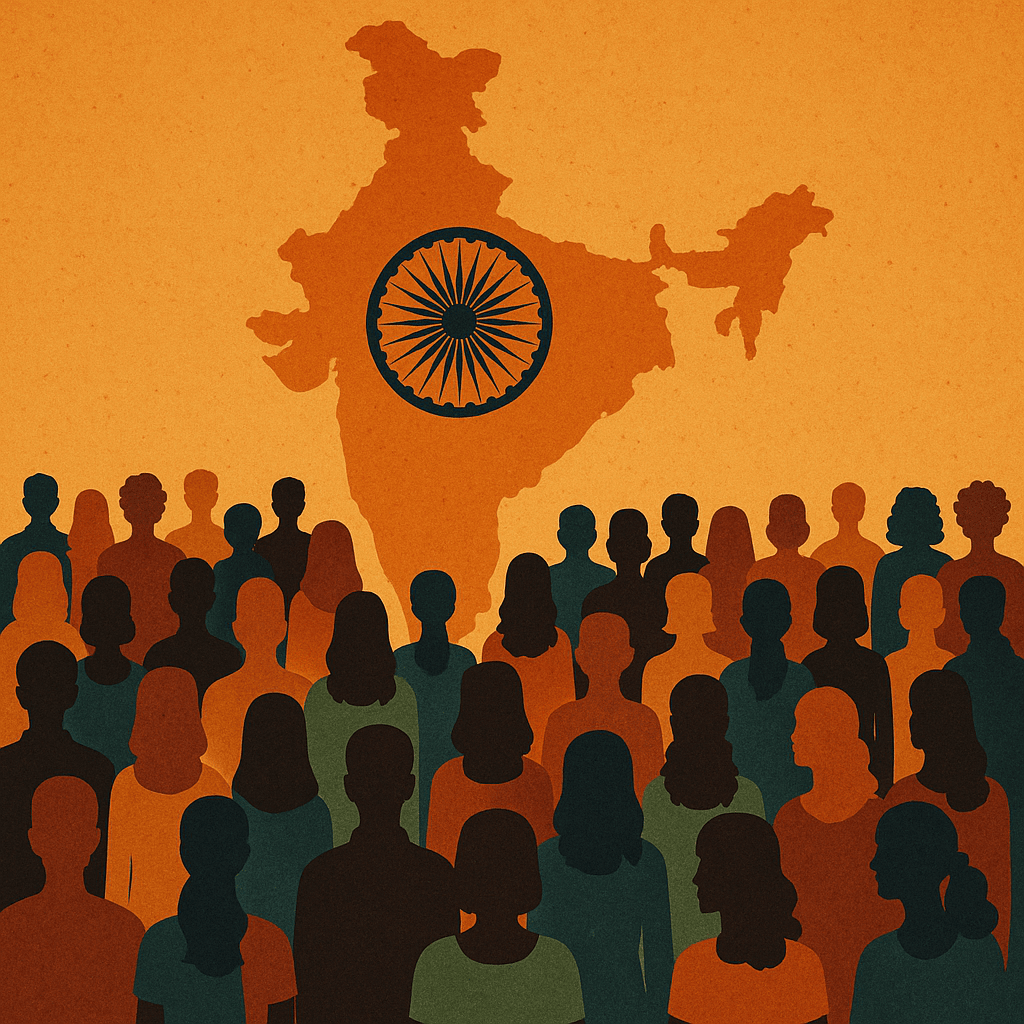India's Demographic Crossroads: Harnessing the Dividend Before Time Runs Out
India’s youthful population offers a historic chance for economic transformation. But without urgent reforms in jobs, healthcare, and gender inclusion, the demographic dividend risks becoming a demographic burden.
India has reached a historic milestone, overtaking China to become the world's most populous nation with 1.428 billion people as of April 2023. This demographic achievement signals India's entry into a critical window of opportunity that could define its economic trajectory for generations. India stands at a pivotal crossroad where its demographic dividend represents a powerful asset, but inadequate healthcare infrastructure and accelerating brain drain threaten to undermine this unprecedented advantage. This analysis examines India's demographic window, evaluates the challenges that could derail this opportunity, and outlines urgent policy interventions required to transform demographic potential into sustained economic prosperity.
Understanding India's Demographic Dividend
The demographic dividend represents a unique economic phenomenon where a country's working-age population (15-64 years) grows substantially larger than its dependent population, creating favourable conditions for accelerated economic growth. This structural shift reduces the economic burden on each working-age individual while expanding productive capacity through increased labour supply, higher savings rates, and enhanced capital formation.
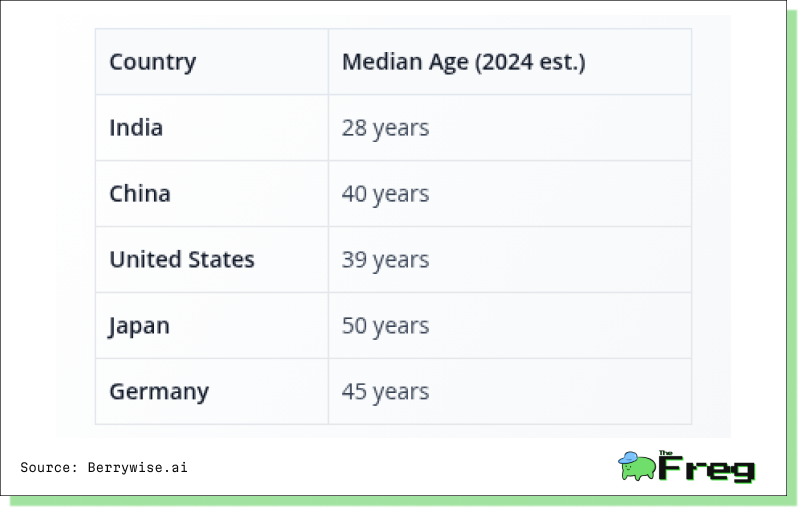
India's demographic transition has been remarkable in scope and speed. The working-age population share has risen from approximately 60% in 2001 to 67% today, with projections indicating it will peak at around 69% during the 2030s before declining post-2050. This expansion has been accompanied by a corresponding decline in the dependency ratio, which has fallen from approximately 66% in 2001 to around 50% currently, with further reduction to 45% projected by the 2030s. India’s fertility rate has steadily declined since the 1950s, providing the demographic precondition for this transition. The graph below illustrates this trajectory.
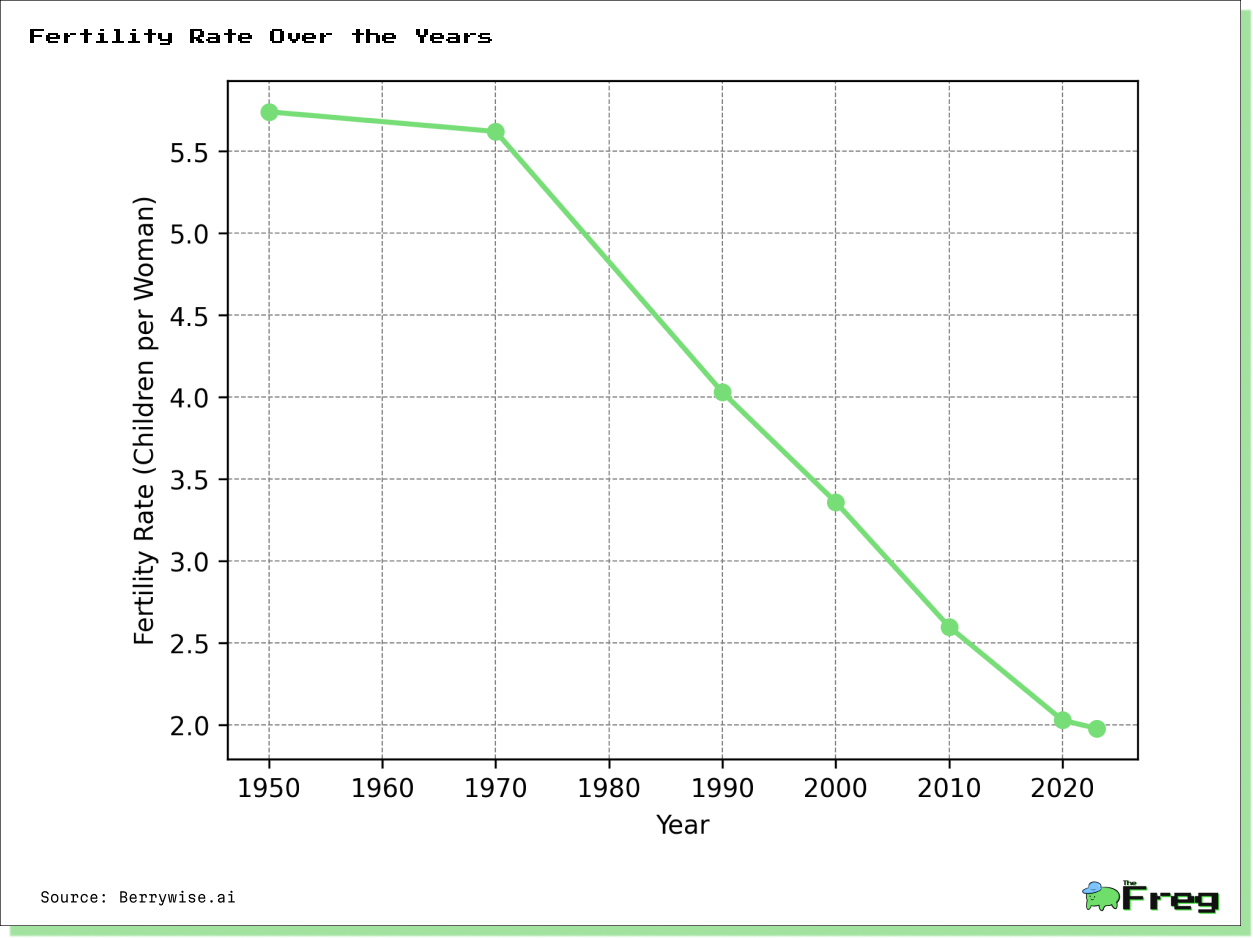
India's position is particularly advantageous due to its youthful demographic profile. The country's median age stands at approximately 28.2 years, making the average Indian significantly younger than their Chinese counterpart at 39 years or European peers at over 44 years. This age advantage positions India favourably in global comparisons while most developed economies grapple with aging populations.
The demographic dividend window for India began around 2010 and is projected to extend through approximately 2050, providing a 40-year opportunity for accelerated economic growth. However, this timeline varies significantly at the sub-national level, with early-transition states like Kerala and Tamil Nadu potentially exiting their demographic dividend phase by the mid-2040s, while late-transition states may extend their window into the 2060s.
How Long Do We Have?
The urgency of India's demographic opportunity cannot be overstated. At the national level, the demographic dividend window spans roughly four decades from 2010 to 2050, with the peak occurring around 2041-2045 when the working-age population share reaches its maximum. This timeline masks significant regional variations that complicate policy planning and implementation.
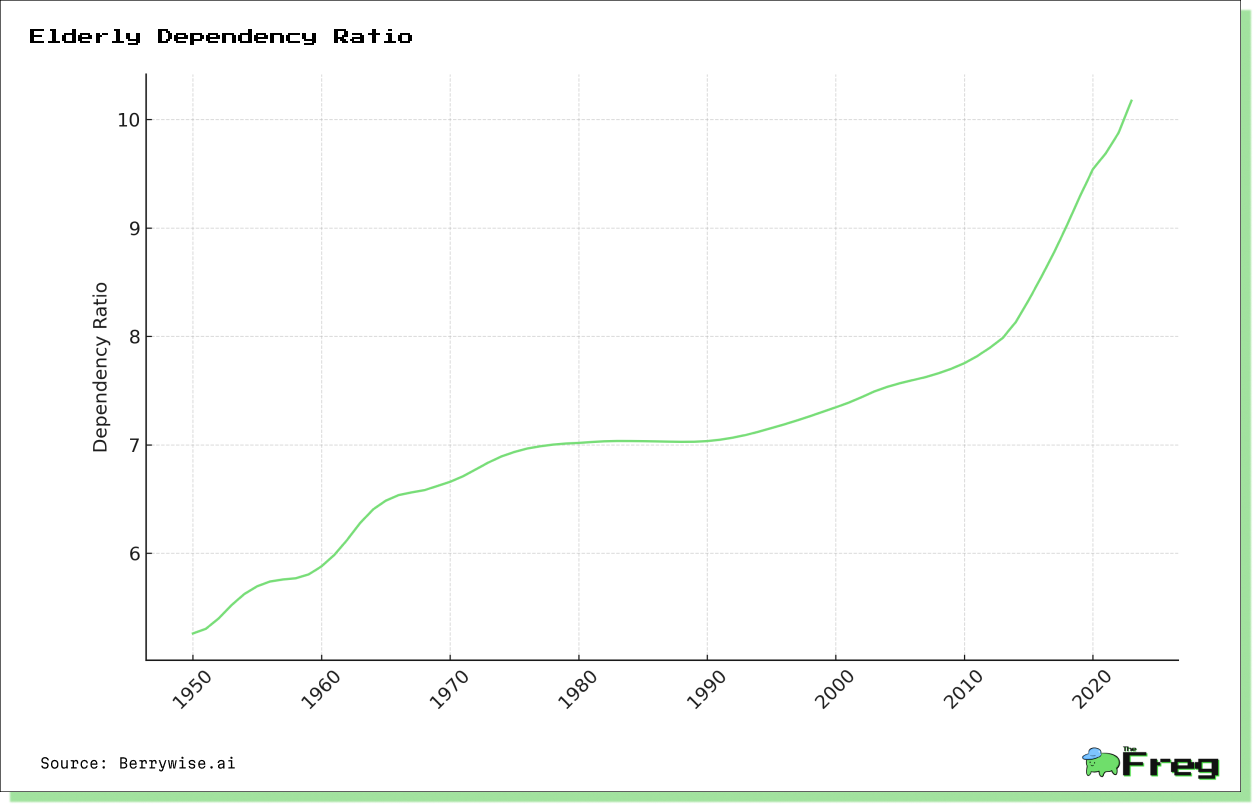
Sub-national differences in demographic transition create a complex landscape of opportunities and challenges. Southern and western states, which experienced earlier fertility declines, are approaching the later stages of their demographic dividend. These regions, including Tamil Nadu, Karnataka, and Kerala, have already reaped substantial benefits from their favourable age structures, contributing significantly to India's economic growth over the past three decades. Conversely, northern and eastern states, particularly in the Hindi heartland, are entering their peak dividend years with substantial potential for catch-up growth.
The staggered nature of these transitions presents both opportunities and risks. While late-transition states offer potential for continued demographic dividends beyond 2050, they face the challenge of building institutional capacity and infrastructure necessary to capitalize on their favourable demographics. Early-transition states must prepare for economic adjustments required as their demographic dividends wane and aging populations place new demands on public resources.
Harnessing the Dividend: Jobs, Skills, Women
The realization of India's demographic dividend depends critically on the economy's ability to productively employ its expanding workforce. Currently, approximately 12 million new workers enter the labour market annually, requiring the creation of at least 11 million jobs per year to maintain employment levels. However, actual job creation averages around 10 million annually, creating a persistent deficit of 2 million jobs each year.
This employment challenge is compounded by a severe skills gap that undermines job quality and productivity. Only approximately 20% of India's workforce possesses formal skills training, compared to a global average of 80%. This disparity reflects decades of underinvestment in vocational education and skills development, leaving millions trapped in low-productivity, informal employment.
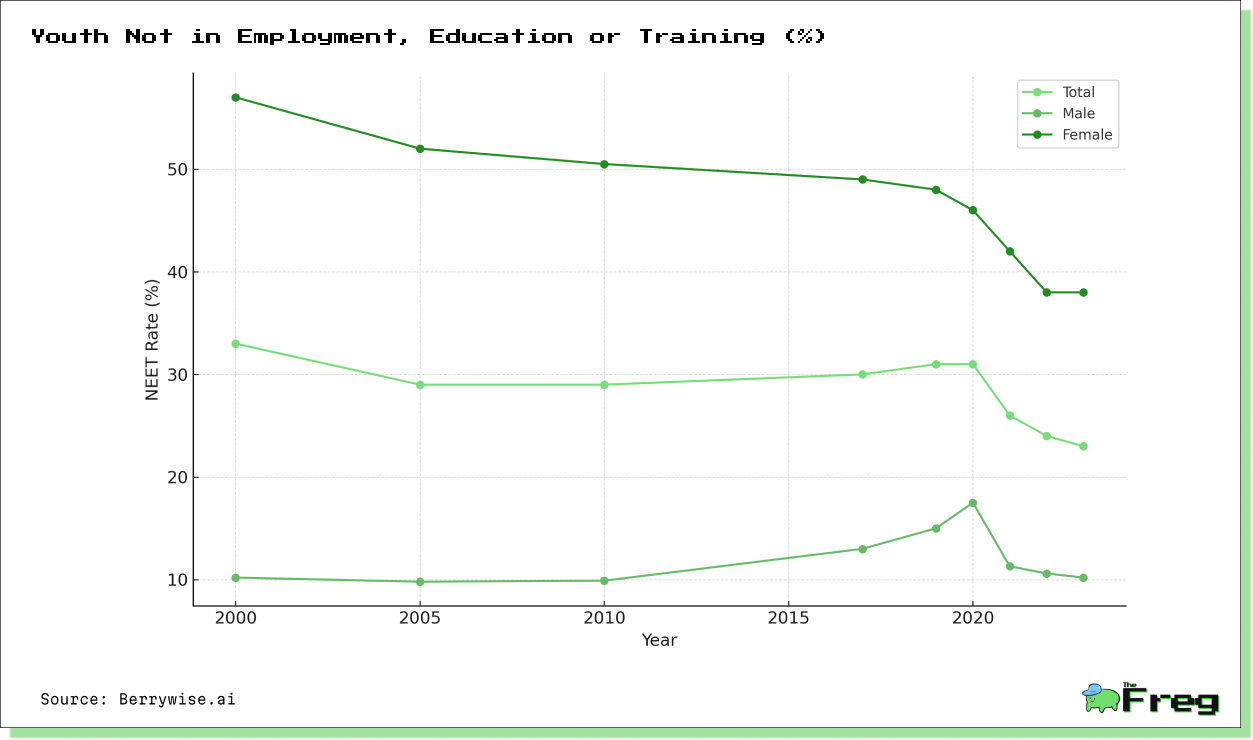
The ability to productively engage India’s growing youth population remains a major challenge. As the chart above illustrates, a significant proportion of Indian youth (15–24 years) remain not in employment, education, or training (NEET), with stark gender disparities. While male NEET rates have remained relatively low, female youth consistently experience NEET rates four to five times higher. Although female NEET has declined from 57% in 2000 to 38.1% in 2023, it remains unacceptably high. This highlights the urgent need for targeted interventions that promote education access, skill development, and formal workforce participation—particularly for young women—to fully harness India’s demographic potential.
Gender participation represents another critical dimension of demographic dividend realization. Female Labour Force Participation Rate (LFPR) in India has historically lagged significantly behind global standards and male participation rates. Recent data shows female LFPR is substantially below male participation, and global averages (of 50-74%). While rural areas report higher female participation at 47.3%, urban female LFPR remains critically low at just 27.2%.
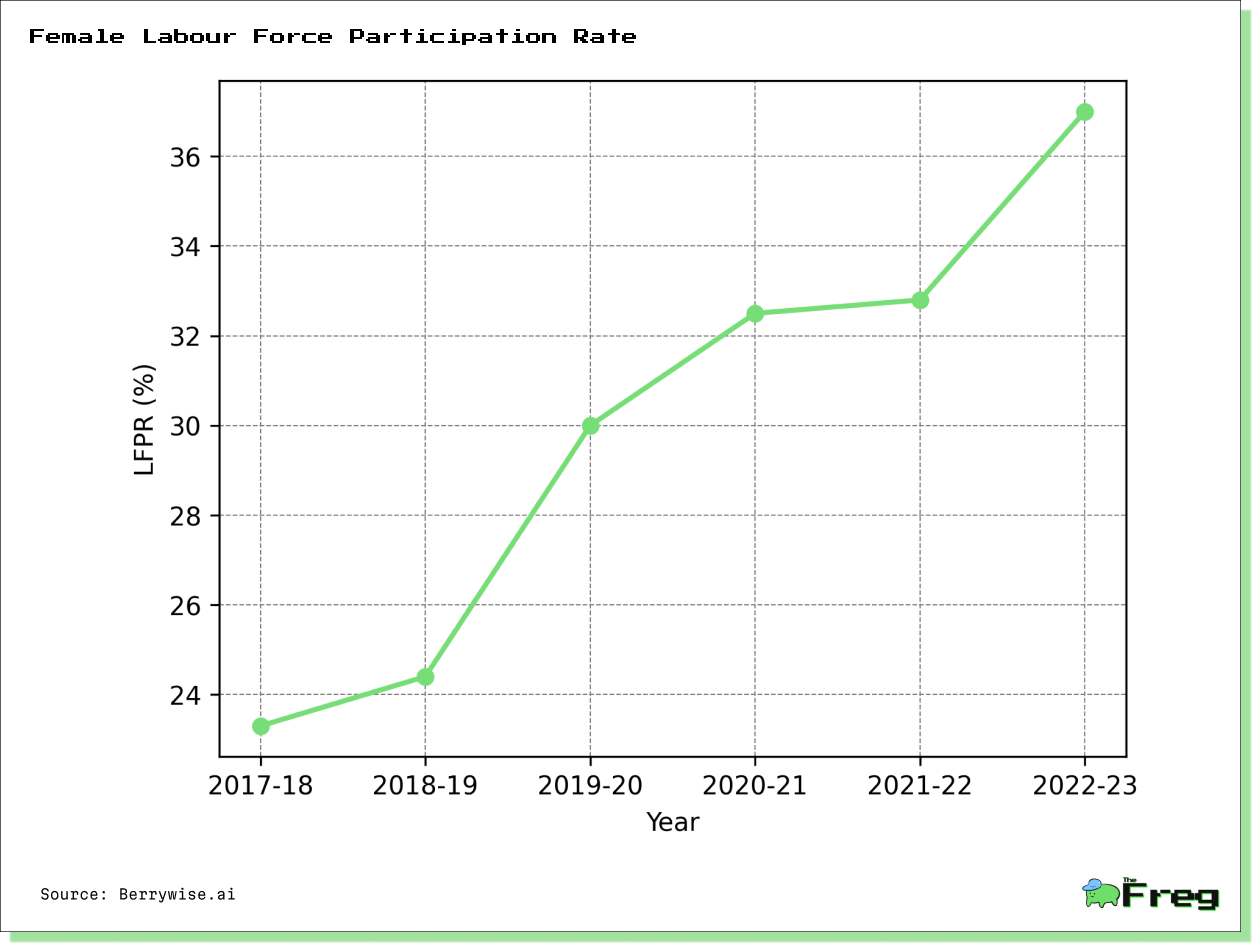
The chart above illustrates the notable recovery in India’s female labour force participation rate over recent years. After remaining stagnant below 25% until 2018–19, female LFPR rose sharply to 37% by 2022–23. While this marks significant progress, especially in rural regions, a large share of female employment remains informal and underpaid—underscoring the need for quality job creation and supportive policy frameworks to unlock the full economic potential of India’s female workforce.
Healthcare Infrastructure: A Potential Liability
India's healthcare system presents a fundamental threat to demographic dividend realization. Despite recent increases, public health spending remains inadequate at 2.1% of GDP in FY2024, well below the National Health Policy target of 2.5% and global standards. This underinvestment has resulted in a healthcare system characterized by significant gaps in coverage, quality, and accessibility.
Key Points:
- Rural areas face severe shortages in both infrastructure and personnel.
- Most government health spending is concentrated in urban areas.
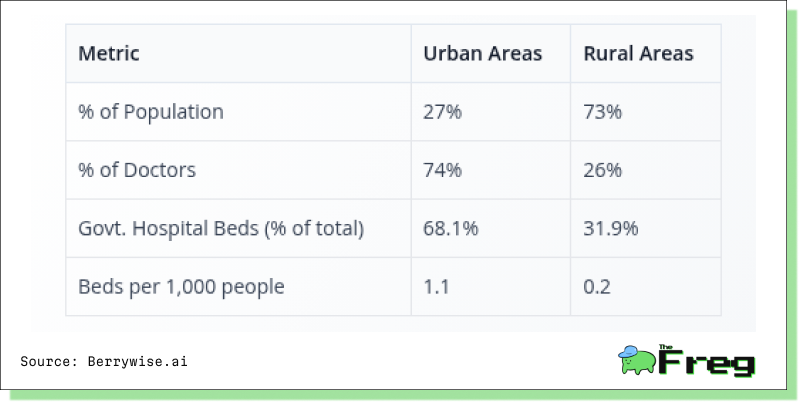
The rural-urban divide in healthcare access represents a particularly acute challenge. Approximately 74% of doctors practice in urban areas, serving only
27% of the population, while rural areas face severe shortages of qualified medical personnel. Government healthcare centres across both rural and urban India grapple with over 23,000 vacant sanctioned medical posts, including more than 9,000 doctor positions in rural Primary Health Centres alone.
The healthcare challenge is further complicated by India's demographic transition itself, elderly population, currently 153 million people aged 60 and above,
is projected to reach 347 million by 2050, more than doubling in three decades. This rapid aging will place unprecedented demands on healthcare infrastructure precisely as the demographic dividend window closes, potentially creating a demographic burden if adequate preparations are not made.
Despite the encouraging downward trend in out-of-pocket healthcare spending—from 64.2% in 2013 to 39.4% in 2022—India remains among the countries with the highest burden of direct medical payments. The graph below illustrates this steady decline, reflecting the impact of expanded public health schemes and insurance coverage. However, with nearly two-fifths of all health expenses still paid directly by households, millions remain vulnerable to financial distress from illness, particularly in rural areas where public healthcare access is weakest. This persistent reliance on out-of-pocket payments continues to undermine equitable access and poses a major obstacle to fully realizing the benefits of India’s demographic dividend.
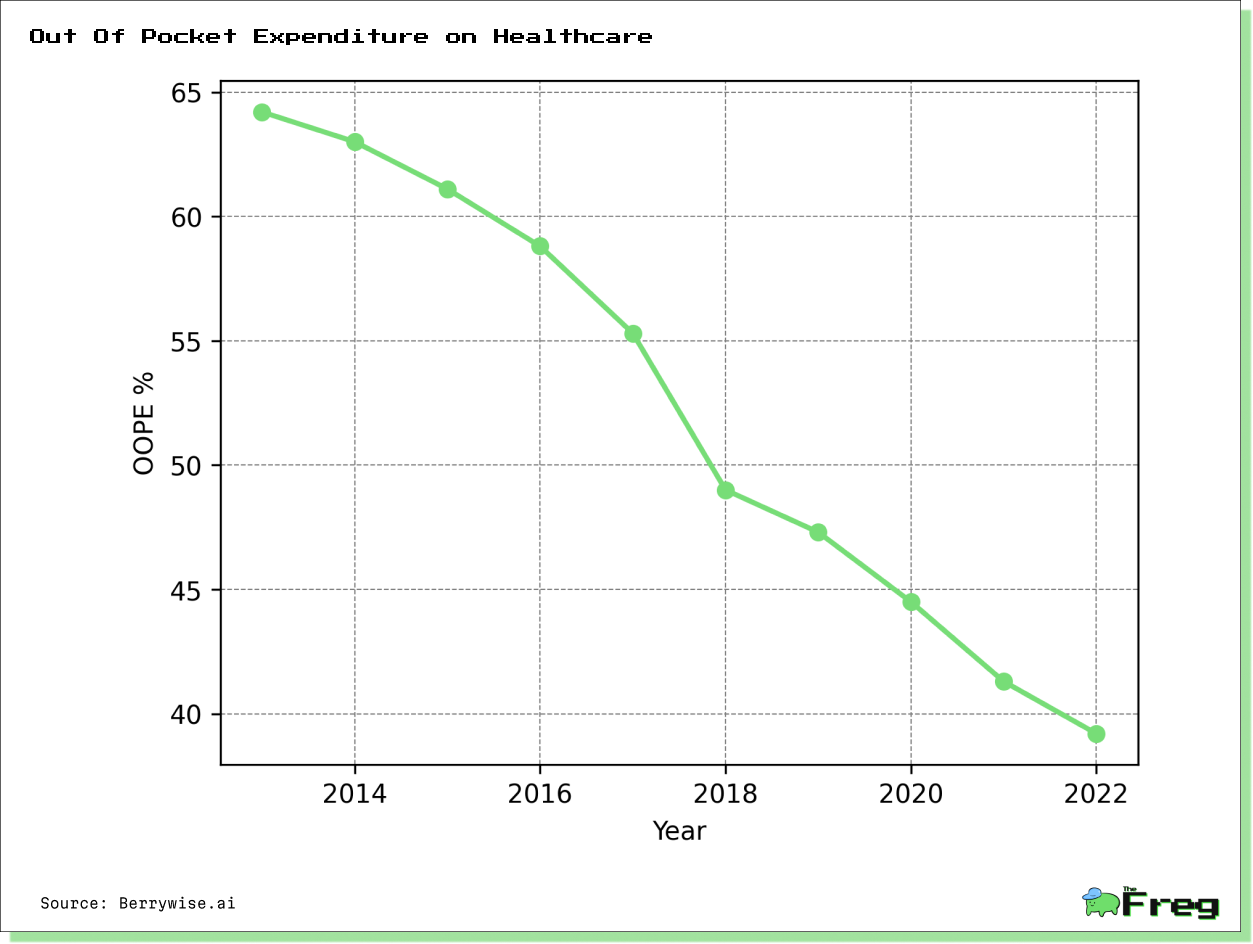
Brain Drain vs Brain Gain
India's skilled migration patterns represent both significant human capital loss and a complex global phenomenon with multiple economic implications. The scale of skilled emigration has reached unprecedented levels, with over 600,000 people leaving India in 2024 alone, continuing an accelerating trend. The healthcare sector has been particularly affected, more than 1 million doctors and 2 million nurses having migrated to developed countries over recent decades.
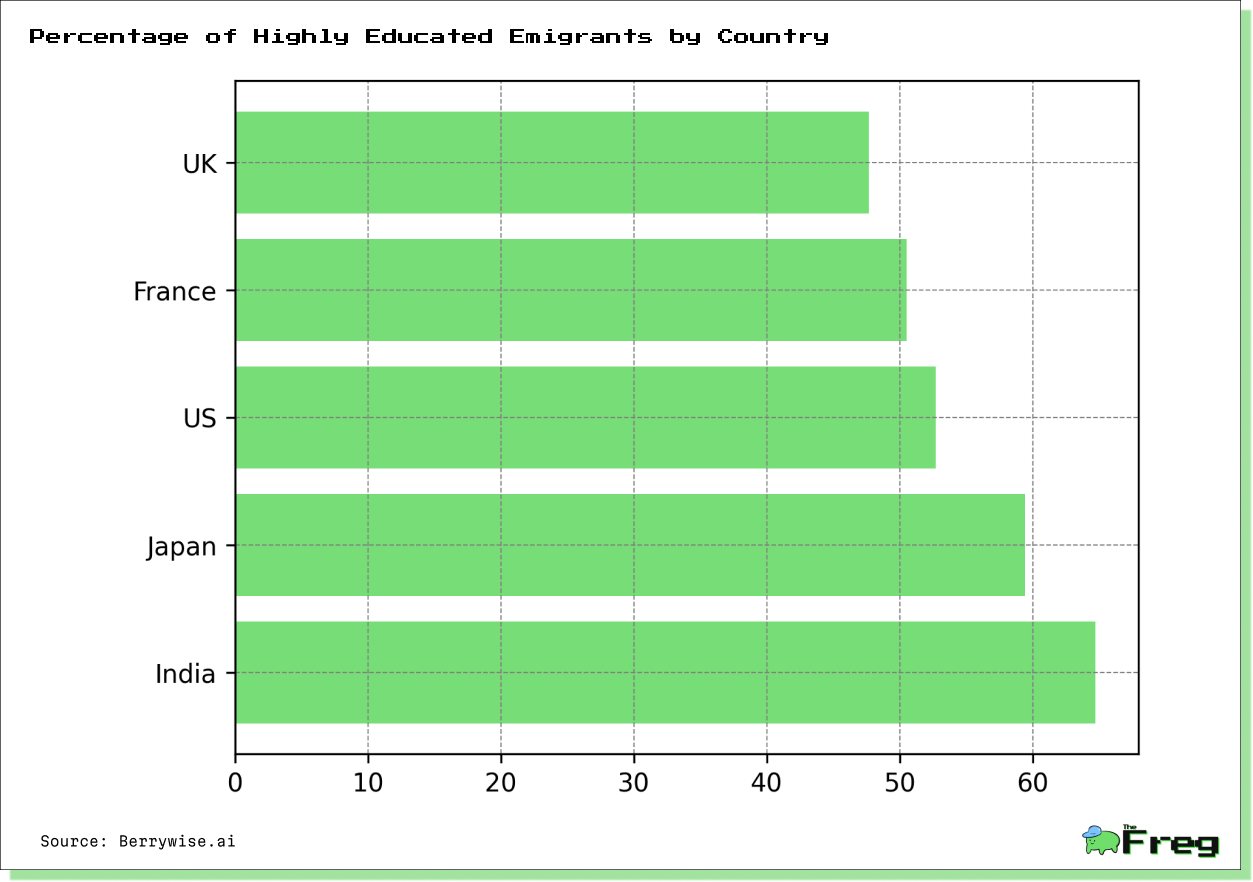
The information technology sector, despite being a cornerstone of India's economic growth, has witnessed the emigration of over 2 million professionals since the early 2000s. This brain drain represents a substantial loss of public investment in education and training, with conservative estimates suggesting India loses approximately $160 billion annually due to skilled emigration. The trend has intensified recently, with emigration clearances for semi-skilled and unskilled workers tripling from 132,675 in 2021 to 398,317 in 2023.
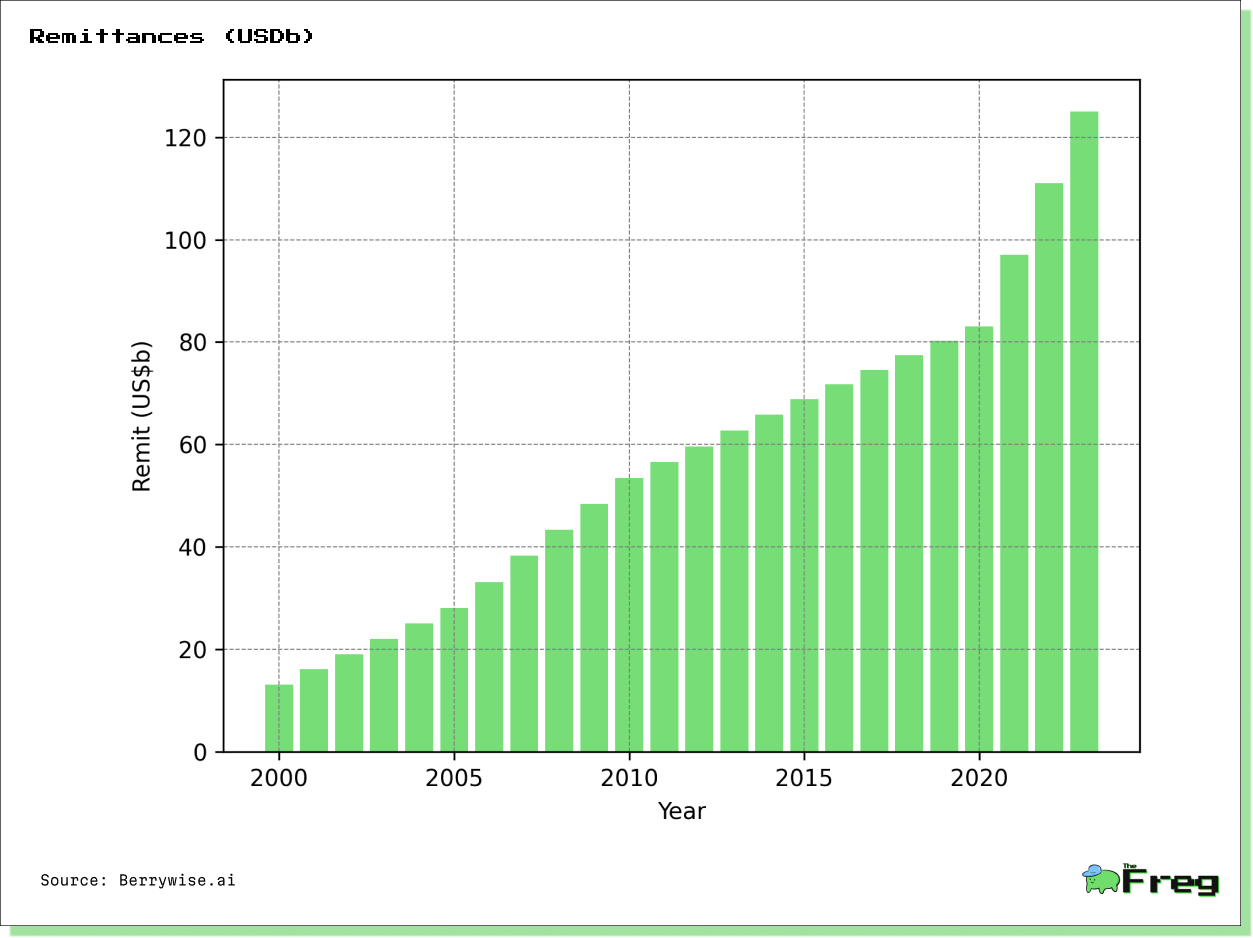
However, this outflow is partially offset by substantial remittance flows that provide crucial foreign exchange earnings. Indians working abroad sent home a record $129.4 billion in 2024, maintaining India's position as the world's largest recipient of remittances. The United States emerged as the largest source, accounting for 27.7% of total remittances, followed by the UAE at 19.2%.
The remittance flows, while beneficial for balance of payments and household incomes, cannot fully compensate for the loss of skilled human capital.
The departure of healthcare professionals, in particular, undermines India's capacity to build robust healthcare infrastructure necessary for demographic dividend realization. Recent trends suggest potential for "brain gain" as global technology companies establish operations in India and government initiatives aim to attract diaspora talent back to the country.
What the Future Holds: Scenarios & Policy Paths
India's demographic dividend realization depends on policy choices made in the immediate future, with three distinct scenarios emerging based on current trends and potential interventions. The business-as-usual scenario assumes continuation of current policy approaches and investment levels. Under this trajectory, unemployment and underemployment persist, healthcare infrastructure deteriorates further, and brain drain accelerates, resulting in a largely wasted demographic dividend.
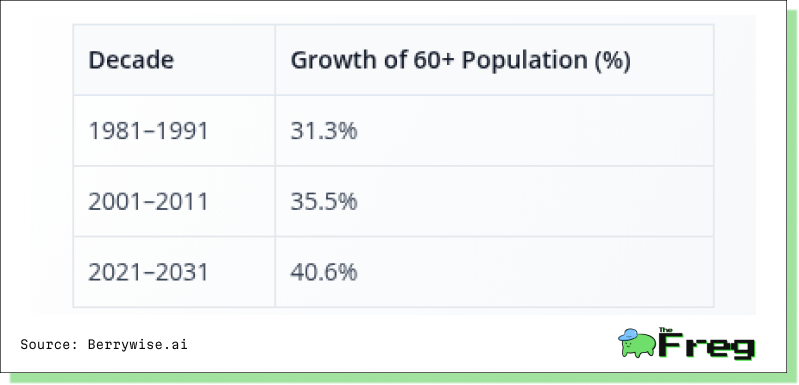
A proactive reform scenario envisions comprehensive policy interventions addressing job creation, education, healthcare, and gender inclusion. This path requires substantial increases in public investment, labour market reforms, and coordinated action across multiple policy domains. Success under this scenario could add approximately 2 percentage points to India's annual per capita GDP growth over the next two decades, as demonstrated by previous research on demographic dividends.
The regional divergence scenario reflects the reality of India's sub-national variations in demographic transition. Early-transition states with stronger institutional capacity and higher human capital indicators continue to prosper and move toward developed economy status. Meanwhile, lagging states fail to capitalize on their demographic opportunities, leading to widening inequalities and potential social tensions.
Critical drivers determining which scenario materializes include infrastructure development, skills training through institutions like the National Skill Development Corporation, healthcare system strengthening, female labour force participation enhancement, and overall governance quality. The window for intervention is narrowing, making immediate policy action essential for positive outcomes.
Realizing India's demographic dividend requires coordinated action across multiple policy domains with specific, measurable targets and timelines. Job creation and skills development must receive immediate priority through enhanced infrastructure investment, manufacturing sector development, and labour law reforms that encourage formal employment. The Skill India initiative and National Skill Development Corporation require substantial scaling to bridge the current skills gap and meet projected workforce demands.
Healthcare system strengthening demands increasing public health expenditure to 3-4% of GDP, with particular focus on rural healthcare infrastructure and medical personnel deployment. The development of comprehensive primary healthcare networks and specialist care facilities must accompany investments in medical education and retention strategies for healthcare professionals.
Brain drain countermeasures should include incentive structures for skilled diaspora return, hybrid employment models enabling global engagement while maintaining Indian residence, and strategic partnerships with destination countries for circular migration arrangements. Medical tourism development and research infrastructure improvements can provide alternative career paths for skilled professionals considering emigration.
Female empowerment requires gender-sensitive education policies, workplace safety improvements, and support systems enabling women's participation in formal employment. Childcare infrastructure, flexible work arrangements, and legal protections against workplace discrimination are essential components of comprehensive gender inclusion strategies.
Sub-national planning must acknowledge the varying stages of demographic transition across Indian states. Early-transition states require different policy approaches focused on managing aging populations and economic diversification, while late-transition states need intensive capacity building for demographic dividend realization.
Conclusion
India possesses a unique and time-limited opportunity through its demographic dividend, with approximately 25 years remaining in a 40-year window that began around 2010. This demographic advantage, characterized by a youthful population and favourable dependency ratios, represents a powerful asset for economic acceleration and development. However, inadequate healthcare infrastructure and accelerating brain drain pose existential threats to dividend realization unless addressed through immediate, coordinated policy intervention.
The challenges are substantial but not insurmountable. Healthcare system deficiencies, skills gaps, gender participation barriers, and human capital flight require comprehensive policy responses that address root causes rather than symptoms. The cost of inaction extends beyond missed economic opportunities to include potential demographic burdens as the population ages without having capitalized on its youthful advantage.
Urgent, coordinated policy action across skills development, employment generation, healthcare strengthening, and gender inclusion represents the only viable path for transforming demographic potential into lasting economic progress. The window for action is narrowing, making the next decade critical for determining whether India's demographic dividend becomes a catalyst for development or a missed opportunity of historic proportions. Success requires sustained political commitment, substantial resource mobilization, and innovative policy approaches that acknowledge both the magnitude of the opportunity and the complexity of the challenges ahead.


